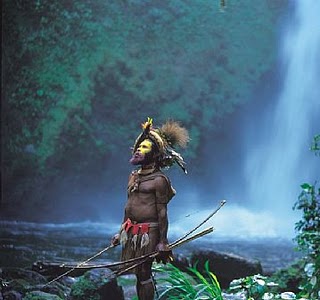“A might roar of released tension reverberated around him, while other spears moved in closer. Yae sank to one knee and called again to Kauwan for mercy, while he tried in vain to pull the barbed spear out of his side.
Kauwan turned away and said simply, “you should have given me a peace child. Then I would have protected you.”
At these words, a vision formed in Yae’s mind, a pain-distorted yet tender vision of Kautap sitting cross-legged by the fire, with the still unnamed baby lying asleep across her lap. The baby! Only that baby could have saved him! But now it was too late.”
The stereotype of the Sawi people seem to revolve around three main concepts; deceitful, uncivilized and cannibalistic. When people first learn about the Sawi culture, they seem to respond with thoughts of inhumanity and disgust. They start to ask questions such as, “why would they go out of their way to deceive others?” Another questions that is frequently asked is, “How can they eat other humans?”
Within this passage it might first seem as the stereotypical Sawi people and culture, however, through this passage we can also see the love and bond of the family. This passage is an illustration of Yae’s ambivalence. In this passage, Yae has been targeted as the victim of deceit and treachery. Within the situation of incredible pain, betrayal and violence, Yae seems to envision his wife and baby. Even though Yae’s reason on envisioning his family was to use the baby as a peace child, the vision is described as tender. Through this vision the reader encounters a glimpse of Yae’s love for his family. At this moment Yae seems to have mixed feelings of regret and fear. However, underneath the feelings of regret and fear, the readers also find Yae’s feeling of love. The main reason why Yae wants to use the baby as the peace is to not only avoid death but also so that he can still support his family. Without Yae, the family will not be able to support itself, in terms of hunting for food and such. When Yae feels regret for not using the baby as the peace child, it is due to the fact that he knows his family will be in adversity.
The reason why this passage holds great significance for me is that this passage seems to represent the Sawi people’s culture before their conversion. Not only does it show the stereotypical perspective, it also shows the tradition related to the significance of the peace child and also the loving bond between the families. This passage clearly says that even in cultures that can be described as “uncivilized” love is still present.










